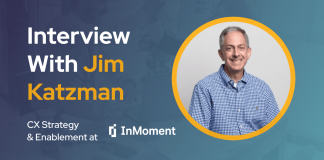Hi Michela, tell us about yourself and your background.
I am a CX Manager with a marketing background who strongly believes in CX to drive business growth and break the silos in the organization. I am currently a Global CX & Innovation Manager at Nespresso Global HQ based in Lausanne, Switzerland; the scope of my role is to ensure that every product we develop for the future of Nespresso is complemented with a differentiating customer experience, as we know that delivering a great and innovative product is not enough if we don’t master the customer experience around it at the same time.
I was born and raised in Italy, and at the age of 16 I started moving around to explore the world and living in different cultures. I moved to the United States on my own to finish high-school and since then I have never stopped exploring. I had the chance to study and work in Melbourne (Australia), Milan (Italy) and London (UK), to finally land in Lausanne (CH) in 2019 right before the pandemic started. I know where I have been so far, but I don’t know where I will go next; life is full of opportunities, and it is so unpredictable that I am not the best person to answer the typical question “Where do you see yourself in 5 years?”.
How did you first start working in the CX space?
At the beginning of my career, I was lucky enough to join a company that was starting a big CX transformation and had the customers always in mind and at the centre of every project — I am referring to Vodafone Italy. I was a newly graduated student coming from a great internship experience at Nestlé, and I was recruited by Vodafone Italy to join their graduate program, one of the best in Italy at that time. I went through a job rotation during my first year and when it was the moment to embark on my next and permanent role a big and customer centric reorganisation took place: a new dedicated CX team was formed.
The name of the team was “Zero-defect customer journey,” reflecting the ambition of the company to deliver a perfect experience to their customers at every stage of the customer journey. Intrigued by the scope and ambition, I decided to apply for a position in the team and that’s when my CX career officially started.
I was responsible for monitoring and improving the customer journeys for landline and mobile customers by identifying paint points to be solved and new opportunity areas to explore. The analytical part was conducted through the analysis of the main CRM, customer service and customer KPIs (such as NPS) and for the improvement and journey design activities I was adopting powerful human-centric methodologies such ad Design Thinking.
This was the start of my love story with everything related to CX; following this first experience I developed my international career covering different CX roles both in different industries at both Global and Market level such as: Vodafone Group Plc and Deloitte Digital in London, E.ON Italy (utilities) and Nespresso Global in Switzerland.
What are some of the common misunderstandings related to customer experience?
I have seen many definitions of “Customer Experience” and many interpretations of what it means for a company to be customer-centric. The reality is that there is not a single definition and that is because customer experience is very broad. One of the common mistakes I see is to consider customer experience = customer service only. I think this is a big mistake as for sure customer service has a key role, but it is not the only way to ensure the delivering of a great experience to your customers. CX indeed needs to be embedded in every role and function, from strategy, to product design, IT, marketing and customer service and all employees should develop a strong customer centric mindset. Customer service is the direct line with customers, but CX must have a key role not only during the last mile but also during the definition of the strategy even before starting to think about the product/service to launch.
Have you seen any interesting new trends in eCommerce this year?
It’s easy to say that the pandemic has accelerated the digitalization of both companies and consumers forcing companies to adapt quickly to the “new normal”.
Shoppers now observe brand content the same way they enjoy following a friend’s feed. With more choices than ever, video content captivates shoppers and steers them closer to the point of purchase. While the most digitally savvy and introvert consumers prefer to purchase online autonomously without any assistance there are those who like to engage and feel the human connection with the brand when using digital channels.
Two of the most interesting trends that raised impressively in the last year are the interactive video content and the virtual shopping experience that connects online customers with a specific store assistant through chat and video consultation – this is one way to humanize the digital experience and replicate as much as possible the retail experience onto digital channels.
E-commerce brands of the future need to entertain and engage — not just sell. They will have to create virtual spaces that feel like spaces; that are alive and lively, human-driven instead of bot-driven, and fun.
eCommerce boomed in 2020, and consumers started leaving more product reviews online. How can we make the most out of this momentum?
I believe both positive and negative reviews can be a great opportunity for any company. Customers decide to spend their time to give feedback about our products and services, for free; it is up to us to take it as an opportunity and exploit it as much as possible to listen to our customers.
Reviews need to be considered as powerful first or second party data as any other CRM data companies store in their system.
I suggest implementing an automated analytical solution to analyze the qualitative feedback, measure the sentiment and detect the most critical cases to follow up with the customers in a timely manner; a close the loop approach, ownership and governance must be put in place in order to be effective at this.
What are some CX companies/solutions you’re keeping your eyes on right now?
Referring to the trends above, at Nespresso we are exploring two solutions that allow to humanize the digital experience; I am talking about HERO and Eko.
Hero is an all-in-one virtual shopping platform to inspire, convert and retain online customers while Eko is a technology company that is building a limitless platform for creating and publishing interactive, choice-driven video experiences.
Here you can have a look at how at Nespresso we leveraged on these trends and technologies to humanise the digital experience for our Vertuo Line prospects and customers.
So many things changed in 2020. While some things are going to return to “normal,” what are new trends and habits you think will stay with us in the long term?
Indeed, many things have changed, and we don’t know for how long they will stay or if they will change. From my point of view, the ways consumers interact now with brands both online and offline will not go back the pre-pandemic habits but will have a long-term impact. The role, setting, function and location of our “home” will also continue to evolve in a way that will make us feel ready in case any unpredictable event happens again.
Do you believe focus groups are still relevant in the era of eCommerce? Why?
I tend to look at focus groups with a bit of skepticism overall, not only in the era of eCommerce. The environment is too much controlled and I am not sure people can freely express themselves without being influenced by the group; of course it depends also on the objective of the research, but I prefer to use different methods than the focus groups.
Last but not least, what is your favorite CX metric?
I am a big fan of the Net Promoter Score (NPS), although I don’t think it is the most precise and reliable metric to measure Customer Experience; we could in fact discuss hours about the 0-10 scale and how it is perceived differently in different countries and cultures, and how reductive it could be to rely on a number that comes from a straight and single question. Despite all these arguments, I believe NPS can be a powerful indicator to easily represent the customer at the different levels of the organization. Measuring top-down and touchpoint NPS and talking daily about it in the organization can be an easy way to foster a customer-centric culture and make sure all employees develop a customer-centric mindset.






